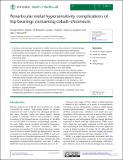Files in this item
Periarticular metal hypersensitivity complications of hip bearings containing cobalt-chromium
Item metadata
| dc.contributor.author | Wu, Dongmei | |
| dc.contributor.author | Bhalekar, Rohan M. | |
| dc.contributor.author | Marsh, Jordan S. | |
| dc.contributor.author | Langton, David J. | |
| dc.contributor.author | Stewart, Alan J. | |
| dc.date.accessioned | 2022-12-12T12:30:04Z | |
| dc.date.available | 2022-12-12T12:30:04Z | |
| dc.date.issued | 2022-12-07 | |
| dc.identifier | 282185501 | |
| dc.identifier | 0d455786-962e-451e-8707-4250ae714b99 | |
| dc.identifier | 85144964337 | |
| dc.identifier | 000896786900003 | |
| dc.identifier.citation | Wu , D , Bhalekar , R M , Marsh , J S , Langton , D J & Stewart , A J 2022 , ' Periarticular metal hypersensitivity complications of hip bearings containing cobalt-chromium ' , EFORT Open Reviews , vol. 7 , no. 11 , pp. 758-771 . https://doi.org/10.1530/EOR-22-0036 | en |
| dc.identifier.issn | 2396-7544 | |
| dc.identifier.uri | https://hdl.handle.net/10023/26574 | |
| dc.description | Funding: The authors gratefully acknowledge the China Scholarship Council for funding a PhD scholarship for DW. | en |
| dc.description.abstract | • Hip bearings composed of cobalt-chromium alloy (metal-on-metal bearings) have been one of the most widely used in joint replacement arthroplasty. Unfortunately, these implants can contribute to a complication called aseptic lymphocyte-dominated vasculitis-associated lesion (ALVAL); a type IV metal hypersensitivity response around the joint. • Consistently with such bearings, increased metal debris can be found in the surrounding fluids and in remote tissues and organs, due to wear and corrosion. It is hypothesised that metal ions released from the prosthesis (including Co2+) can potentially form haptens with proteins such as serum albumin in synovial fluid that in turn, elicit ALVAL. • Generally, elevated cobalt and chromium levels in synovial fluids may indicate implant failure. However, such measurements cannot be used as a reliable tool to predict the onset of ALVAL. To detect ALVAL, some diagnostic tests, questionnaires and imaging techniques have been used clinically with some success, but a standardised approach is lacking. • At present, guidelines for implant usage and patient management are ambiguous and inconsistent across healthcare authorities. To reduce and better manage the development of ALVAL, further research into the precise molecular mechanism(s) by which ALVAL develops is urgently needed. • Identification of diagnostic and prognostic biomarkers for ALVAL are required, as are more standardised guidelines for surgery and patient management. | |
| dc.format.extent | 14 | |
| dc.format.extent | 1415467 | |
| dc.language.iso | eng | |
| dc.relation.ispartof | EFORT Open Reviews | en |
| dc.subject | Metal-on-metal implant | en |
| dc.subject | Metal ion release | en |
| dc.subject | Hip replacement | en |
| dc.subject | ALVAL | en |
| dc.subject | Immunology | en |
| dc.subject | QR180 Immunology | en |
| dc.subject | MCC | en |
| dc.subject.lcc | QR180 | en |
| dc.title | Periarticular metal hypersensitivity complications of hip bearings containing cobalt-chromium | en |
| dc.type | Journal item | en |
| dc.contributor.institution | University of St Andrews. Cellular Medicine Division | en |
| dc.contributor.institution | University of St Andrews. School of Medicine | en |
| dc.contributor.institution | University of St Andrews. Sir James Mackenzie Institute for Early Diagnosis | en |
| dc.contributor.institution | University of St Andrews. Biomedical Sciences Research Complex | en |
| dc.contributor.institution | University of St Andrews. Institute of Behavioural and Neural Sciences | en |
| dc.identifier.doi | https://doi.org/10.1530/EOR-22-0036 | |
| dc.description.status | Peer reviewed | en |
This item appears in the following Collection(s)
Items in the St Andrews Research Repository are protected by copyright, with all rights reserved, unless otherwise indicated.

